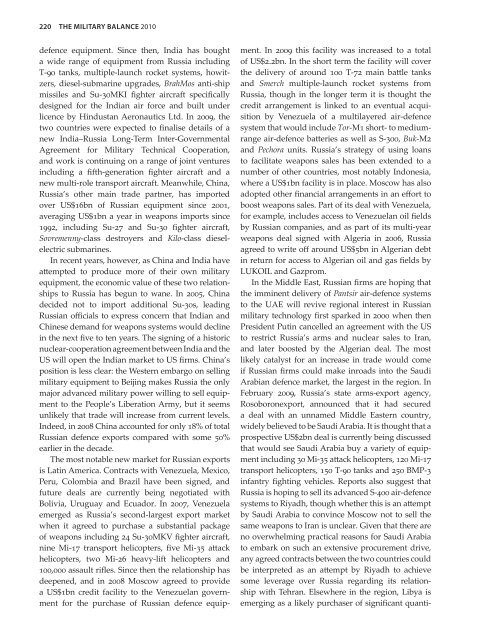Create successful ePaper yourself
Turn your PDF publications into a flip-book with our unique Google optimized e-Paper software.
220 The MiliTaRy Balance 2010<br />
defence equipment. Since then, India has bought<br />
a wide range of equipment from Russia including<br />
T-90 tanks, multiple-launch rocket systems, howitzers,<br />
diesel-submarine upgrades, BrahMos anti-ship<br />
missiles and Su-30MKI fighter aircraft specifically<br />
designed for the Indian air force and built under<br />
licence by Hindustan Aeronautics Ltd. In 2009, the<br />
two countries were expected to finalise details of a<br />
new India–Russia Long-Term Inter-Governmental<br />
Agreement for Military Technical Cooperation,<br />
and work is continuing on a range of joint ventures<br />
including a fifth-generation fighter aircraft and a<br />
new multi-role transport aircraft. Meanwhile, China,<br />
Russia’s other main trade partner, has imported<br />
over US$16bn of Russian equipment since 2001,<br />
averaging US$1bn a year in weapons imports since<br />
1992, including Su-27 and Su-30 fighter aircraft,<br />
Sovremenny-class destroyers and Kilo-class dieselelectric<br />
submarines.<br />
In recent years, however, as China and India have<br />
attempted to produce more of their own military<br />
equipment, the economic value of these two relationships<br />
to Russia has begun to wane. In 2005, China<br />
decided not to import additional Su-30s, leading<br />
Russian officials to express concern that Indian and<br />
Chinese demand for weapons systems would decline<br />
in the next five to ten years. The signing of a historic<br />
nuclear-cooperation agreement between India and the<br />
US will open the Indian market to US firms. China’s<br />
position is less clear: the Western embargo on selling<br />
military equipment to Beijing makes Russia the only<br />
major advanced military power willing to sell equipment<br />
to the People’s Liberation Army, but it seems<br />
unlikely that trade will increase from current levels.<br />
Indeed, in 2008 China accounted for only 18% of total<br />
Russian defence exports compared with some 50%<br />
earlier in the decade.<br />
The most notable new market for Russian exports<br />
is Latin America. Contracts with Venezuela, Mexico,<br />
Peru, Colombia and Brazil have been signed, and<br />
future deals are currently being negotiated with<br />
Bolivia, Uruguay and Ecuador. In 2007, Venezuela<br />
emerged as Russia’s second-largest export market<br />
when it agreed to purchase a substantial package<br />
of weapons including 24 Su-30MKV fighter aircraft,<br />
nine Mi-17 transport helicopters, five Mi-35 attack<br />
helicopters, two Mi-26 heavy-lift helicopters and<br />
100,000 assault rifles. Since then the relationship has<br />
deepened, and in 2008 Moscow agreed to provide<br />
a US$1bn credit facility to the Venezuelan government<br />
for the purchase of Russian defence equip-<br />
ment. In 2009 this facility was increased to a total<br />
of US$2.2bn. In the short term the facility will cover<br />
the delivery of around 100 T-72 main battle tanks<br />
and Smerch multiple-launch rocket systems from<br />
Russia, though in the longer term it is thought the<br />
credit arrangement is linked to an eventual acquisition<br />
by Venezuela of a multilayered air-defence<br />
system that would include Tor-M1 short- to mediumrange<br />
air-defence batteries as well as S-300, Buk-M2<br />
and Pechora units. Russia’s strategy of using loans<br />
to facilitate weapons sales has been extended to a<br />
number of other countries, most notably Indonesia,<br />
where a US$1bn facility is in place. Moscow has also<br />
adopted other financial arrangements in an effort to<br />
boost weapons sales. Part of its deal with Venezuela,<br />
for example, includes access to Venezuelan oil fields<br />
by Russian companies, and as part of its multi-year<br />
weapons deal signed with Algeria in 2006, Russia<br />
agreed to write off around US$5bn in Algerian debt<br />
in return for access to Algerian oil and gas fields by<br />
LUKOIL and Gazprom.<br />
In the Middle East, Russian firms are hoping that<br />
the imminent delivery of Pantsir air-defence systems<br />
to the UAE will revive regional interest in Russian<br />
military technology first sparked in 2000 when then<br />
President Putin cancelled an agreement with the US<br />
to restrict Russia’s arms and nuclear sales to Iran,<br />
and later boosted by the Algerian deal. The most<br />
likely catalyst for an increase in trade would come<br />
if Russian firms could make inroads into the Saudi<br />
Arabian defence market, the largest in the region. In<br />
February 2009, Russia’s state arms-export agency,<br />
Rosoboronexport, announced that it had secured<br />
a deal with an unnamed Middle Eastern country,<br />
widely believed to be Saudi Arabia. It is thought that a<br />
prospective US$2bn deal is currently being discussed<br />
that would see Saudi Arabia buy a variety of equipment<br />
including 30 Mi-35 attack helicopters, 120 Mi-17<br />
transport helicopters, 150 T-90 tanks and 250 BMP-3<br />
infantry fighting vehicles. Reports also suggest that<br />
Russia is hoping to sell its advanced S-400 air-defence<br />
systems to Riyadh, though whether this is an attempt<br />
by Saudi Arabia to convince Moscow not to sell the<br />
same weapons to Iran is unclear. Given that there are<br />
no overwhelming practical reasons for Saudi Arabia<br />
to embark on such an extensive procurement drive,<br />
any agreed contracts between the two countries could<br />
be interpreted as an attempt by Riyadh to achieve<br />
some leverage over Russia regarding its relationship<br />
with Tehran. Elsewhere in the region, Libya is<br />
emerging as a likely purchaser of significant quanti-


